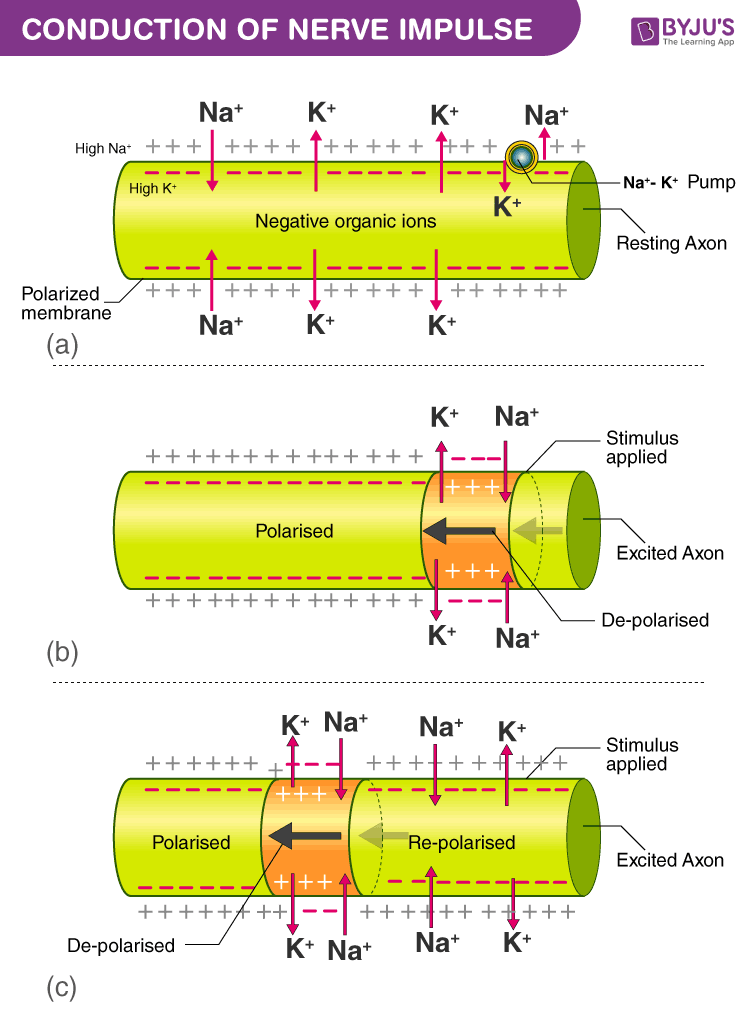A nerve impulse is the electric signals that pass along the dendrites to generate a nerve impulse or an action potential. An action potential is due to the movement of ions in and out of the cell. It specifically involves sodium and potassium ions. They are moved in and out of the cell through sodium and potassium channels and sodium-potassium pump.
Conduction of nerve impulse occurs due to the presence of active and electronic potentials along the conductors. Transmission of signals internally between the cells is achieved through a synapse. Nerve conductors comprise relatively higher membrane resistance and low axial resistance. The electrical synapse has its application in escape reflexes, heart and in the retina of vertebrates. They are mainly used whenever there is a requirement of fast response and timing being crucial. The ionic currents pass through the two cell membrane when the action potential reaches the stage of such synapse.
Mechanism of Transmission of Nerve Impulse

The axon or nerve fibres are in the form of a cylinder wherein the interior of the axon is filled with axoplasm and the exterior is covered with axolemma. The nerve fibres are immersed in ECF. The solution is in the ionic form that is present in axoplasm and extracellular fluid or ECF.
Outside the axon, the negatively charged chloride ions are neutralized in the presence of positively charged sodium ions. Negatively charged protein molecules are neutralized in the presence of potassium ions within the axoplasm. The membrane of a neuron is -ve inside and +ve outside. Resting potential would be the difference in charge. The difference in charge might vary from seventy to ninety millivolts, as a result, the membrane would be polarized. Sodium potassium pump operates to keep resting potential in equilibrium.
The pump is placed on the axon membrane. Now the potassium ions are pumped from ECF to axoplasm and sodium ions are pumped from axoplasm to ECF.
The sodium-potassium pump stops operating when a stimulus is applied to a membrane of a nerve fibre. The stimulus could be either electrical, chemical or mechanical. The potassium ions rush outside the membrane and sodium ions rush inside the membrane as a result negative charges are present outside and positive charges are present inside.
The nerve fibres are either depolarized or they are said to be in the action potential. The action potential travelling along the membrane is called the nerve impulse. It is around + 30 mV. The sodium-potassium pump starts to operate once the action potential is completed. As a result, the axon membrane will obtain a resting potential by repolarization.
Now the process takes place in reverse order. It is a reversal of the process that has taken place during an action potential. Here, potassium ions will be rushed inside and sodium ions will be rushed outside. Impulse would not be transmitted through the nerve fibre during the refractory period.
In the case of white fibres, saltatory propagation takes place. That is impulse jumps from node to node and it increases with increase in the speed of nerve impulse. It is around twenty times faster compared to that of the non-medullated nerve fibres. The transmission of nerve impulse would rely upon the diameter of the fibre. For instance, the nerve impulse of a mammal is one twenty meters per second whereas nerve impulse of a Frog is 30 meters per second.

To learn more about nerve impulse, download BYJU’S-The Learning App.
Also read:

very helpful and creative in its aspects of display and presentation